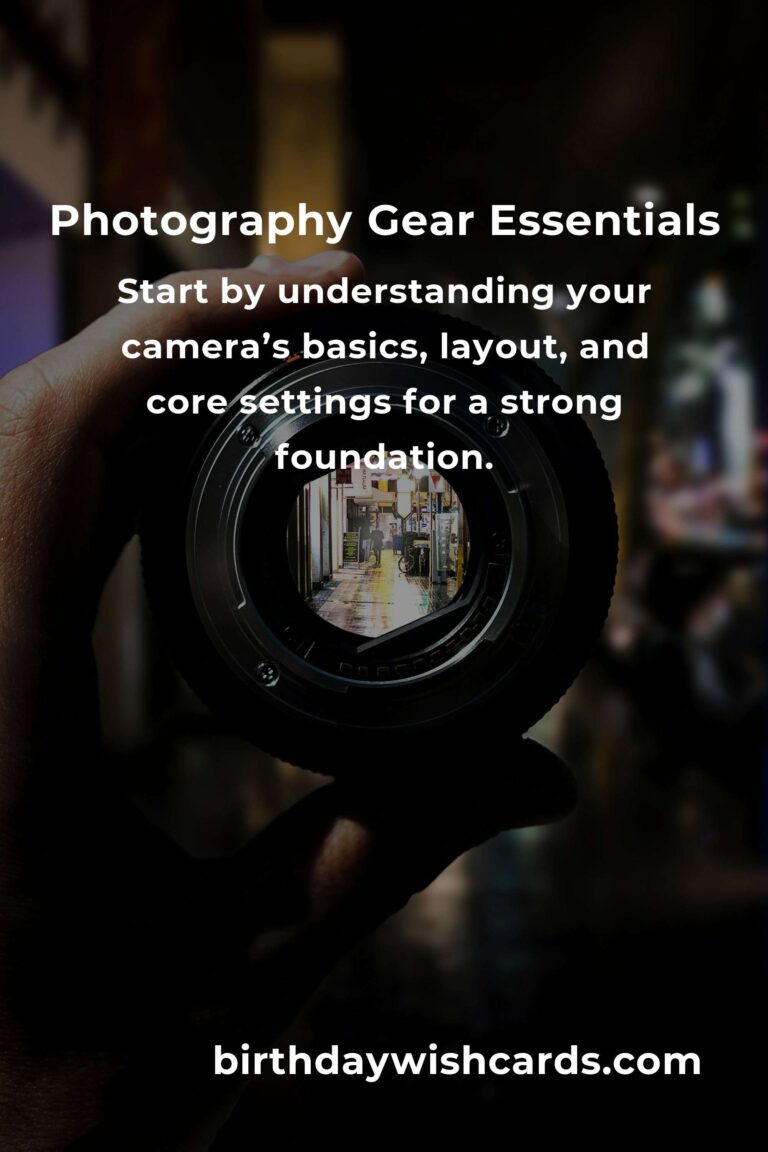
Photography is more than just pointing a camera and clicking a button—it’s a blend of creativity, technical know-how, and hands-on experience with the right gear. Whether you’re a beginner or brushing up before a special shoot, you can master your photography gear in just four days. This intensive guide is tailored to fast-track your skills, so let’s dive in.
Day 1: Getting to Know Your Camera
The very first step to mastering photography gear is understanding the core piece: your camera. Today is dedicated to exploring your camera’s basics, its manual, and a little about its history. A good foundation will set the tone for everything that follows.
Unbox and Identify
If your camera is new, unbox it carefully. Lay out all parts: body, lens, caps, straps, battery, charger, cables, and manuals. Familiarize yourself with every item.
Study the User Manual
While manuals might seem tedious, they’re rich sources of specific instructions for your camera model. Pay attention to the following:
- Button layout
- Menu navigation
- Settings overview
Key Camera Parts
Get to know these essential camera parts:
- Lens Mount: Where different lenses connect
- Mode Dial: Auto, manual, aperture, and shutter priorities
- Viewfinder/Screen: Composing your shots
- Memory Card Slot: Storing your photos
Hands-On Exercise
Insert the battery and memory card, attach the lens, power on the camera, and take a test shot in auto mode. Switch between the LCD and viewfinder, and review the image.
Pro Tip
Spend time setting the date, time, and formatting your memory card to avoid future issues.
Day 2: Mastering Camera Settings & Modes
Now that you can comfortably handle your camera, it’s time to dig deeper into settings and shooting modes that shape your photos.
The Exposure Triangle
The “exposure triangle” consists of ISO, shutter speed, and aperture. These three functions govern how light or dark your image will be and play a key role in creative effects.
- ISO: Camera sensor sensitivity. Higher numbers mean more brightness (and potentially more grain).
- Aperture: Lens opening size. Measured in f-stops, it influences depth of field (background blur).
- Shutter Speed: How long the sensor is exposed to light. Slower speeds capture motion blur; faster speeds freeze action.
Camera Modes
Modern cameras provide several shooting modes. Learn what these do:
- Auto: The camera decides all settings. Best for snapshots.
- Program: Camera sets shutter and aperture; you control other settings.
- Aperture Priority (A/Av): You set the f-stop, camera sets shutter speed.
- Shutter Priority (S/Tv): You set shutter speed, camera sets aperture.
- Manual: Full control over shutter and aperture.
Hands-On Exercise
Set up a simple scene and take three photos—one in Auto, one in Aperture Priority, and one in Manual mode. Compare results and note differences in exposure and focus.
Other Key Settings
- White Balance
- Metering (Evaluative, Spot, Center-weighted)
- Focus Modes (Single, Continuous, Manual)
- Image Quality (JPG vs RAW)
Spend time experimenting with each setting.
Day 3: Lenses, Filters, and Light Tools
Beyond the camera body, your gear includes lenses, filters, and lighting accessories. Mastering these vastly broadens your creative palette.
Types of Lenses
- Kit Lens: Good all-rounder, often 18-55mm.
- Prime Lens (Fixed Focal): Sharp, wide aperture (e.g., 50mm f/1.8), great for portraits.
- Telephoto: Longer zoom, ideal for wildlife or sports.
- Wide-angle: Expansive scenes—landscapes or architecture.
Lens Care & Changing Lenses
Practice changing lenses safely to prevent dust entering the sensor. Always power off, point the mount downwards, and keep caps handy.
Filters
- UV Filter: Basic lens protection
- Circular Polarizer: Reduces glare, enhances colors
- ND Filter: Allows long exposures in daylight
Test with and without filters to see effects. Remember to clean them regularly!
Lighting Gear
Lighting can make or break your photo. Explore these tools:
- On-/Off-camera flash
- Reflectors
- Diffusers
- Light stands and softboxes
Practice shooting with natural light, then add a reflector or flash and compare the difference. Note how angles and intensity change the mood of your images.
Day 4: Putting It All Together – Shooting, Reviewing, and Maintenance
It’s time to apply your knowledge in real-world shooting. Today, you’ll plan a mini-shoot, evaluate your images, and learn to care for and properly store your equipment.
Plan Your Shoot
- Pick a subject: portrait, still life, outdoors, pets, or cityscapes.
- Plan gear: choose lens and filters appropriate for your theme.
- Set objectives: e.g., create dramatic depth of field, freeze action, or capture sunset colors.
Shoot and Experiment
Take multiple shots, adjusting settings and equipment. Try bracketing exposures, changing focus modes, or introducing different light sources.
Review and Edit
- Upload photos to your computer
- Review images for sharpness, exposure, and composition
- Use basic editing tools (like Lightroom or mobile apps) to enhance contrast and color
Gear Care and Maintenance
- Clean your lens and camera body: Use microfiber cloths and air blowers
- Remove batteries if not using for a while
- Store in a dry place with silica gel
- Backup your images: Use external drives or cloud storage
Advanced Next Steps
After these four days, you’ll be comfortable with your gear and ready for creative exploration. Continue learning by experimenting with new settings, taking online classes, and joining photography groups. Remember—gear is just a tool; your unique vision brings photos to life!
Frequently Asked Questions About Photography Gear
Can I master photography gear in just 4 days?
Yes—with focused, hands-on practice, you can become confident operating your equipment in four days. Mastery grows with continued use and practice.
Should I buy expensive gear to start?
No. Understanding and maximizing your current camera is more important than having the latest model. Upgrade as your skills and needs grow.
How do I choose the right lens?
Select lenses based on your interests (portraits, landscapes, sports, macro, etc.), then invest in quality over quantity.
What are essential accessories for beginners?
Extra batteries, memory cards, a sturdy tripod, lens cleaning kit, and a basic filter are ideal to start with.
Conclusion
Learning to master your photography gear doesn’t have to take years. By dedicating four intensive days to hands-on practice, attention to detail, and a little creative experimentation, you’ll be ready to capture stunning images and troubleshoot most gear issues. Remember, the journey has just begun—happy shooting!
Mastering photography gear is achievable in just four days with focused, hands-on learning.
Start by understanding your camera’s basics, layout, and core settings for a strong foundation.
Experimenting with exposure, shooting modes, and lens options rapidly builds your confidence.
Light modifiers, filters, and good gear maintenance are key to photographic success.
Continuous practice and creative exploration turn technical knowledge into stunning images.
#photography #cameragear #photographytips #beginnerphotographer #gearsetup #photoequipment #learnphotography













